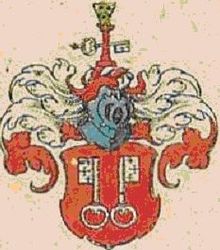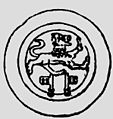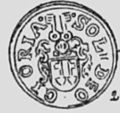Gittelde (noble family)
The Gittelde family , an aristocratic family from Lower Saxony, named themselves after the capital of Getlithi / Getlede = Gittelde , which was originally in Liesgau or Hlis-go, also Get-lithis-Gau . The oldest members of the von Gittelde family known in a document are Bertoldus 1143, and the brothers Adalhart and Widego (f) in a document from Heinrich the Lion , 1154. The next documented member of the von Gittelde family is Thetmar in a document from 1210. This is followed by Basil I ., Ghiso, Gunzelin and Hermann I between 1230 and 1250. Hermann I was provost in Hildesheim , Basil IV canon in Goslar . In 1333 the lords of Gittelde were canons of Gandersheim.
As their coat of arms and the joint ownership of Castle and County of Westerhof show , they were related to those of Westerhof and those of Bovenden . This was last seen in 1566 with the marriage between Hans VIII von Gittelde and Anna von Bovenden. Hans VIII was district administrator for Duke Heinrich Julius (Braunschweig-Wolfenbüttel) . With Heinrich Julius von Gittelde, the male line died out in 1638. Their property passed to von Diepenbrock and von Morungen as their closest living relatives.
Historical classification of the Lords of Gittelde
Reinhard Wenskus has pointed out that the names Widegow and Adalhard were common among the Billungers until the 10th century . It fits that King Otto I owned by Billung in 953 a. a. exchanged for Gelithi, which he transferred to the St. Mauritius Monastery in Magdeburg. The name of the first recorded Count of Liesgau was Adalger, 889. In view of the current sources, it can be assumed that the noble lords of Gittelde are cognatic descendants of the Billunger, who were also directly related to the Counts of Katlenburg . This results not only from the extensive property holdings of the von Gittelde in Liesgau as around Gittelde, but from the fact that they, like the Counts of Katlenburg and Counts of Winzenburg, bailiffs of the Magdeburg diocese, were later the Duke of Brunswick.
In addition, the von Gittelde took over the exercise of the right to mint from the Magdeburg bailiffs and the Brunswick dukes around 1240. The von Gittelde coat of arms, two vertical keys facing away from each other, has appeared on Gittelder coins since the time of Duke Otto I (Braunschweig) . For the last time, the von Gittelde coat of arms can be found on two coins from Emperor Matthias from the years 1619/20, i.e. the time of the Thirty Years War .
literature
- Karl Bege : History of some of the most famous castles and families in the Duchy of Braunschweig, 1844
- J.Fr. Böhmer: Regesta on the history of the Archbishops of Mainz, Vol. I + II, 1877, 1883
- Hermann Guthe : The Lands of Braunschweig and Hanover, 1888
- HA Lüntzel: History of the diocese and city of Hildesheim, 1858
- HA Lüntzel: The oldest diocese Hildesheim, 1837
- Georg Max: History of the Principality of Grubenhagen Vol. I + II. 1862
- Ludwig Schrader: The oldest dynasty tribes between Leine, Weser and Diemel, 1837
- Heinrich Sudendorf: Document book on the history of the dukes of Braunschweig, 11 volumes, 1859 to 1883
- Documents of the Walkenried Monastery, 1852, Vol. II.
- Document book of the Hochstift Hildesheim, Vol. I. - III, 1896–1903
- Reinhard Wenskus: Saxon tribal nobility and Franconian imperial nobility, 1976
Individual evidence
- ↑ Document book Hochstift Hildesheim, Vol. I., No. 231
- ↑ R. Wenskus: Saxon tribes nobility p. 190f
- ↑ Orig. Guelf. III. P. 470
- ↑ Julius Menadier: Gittelder Pfennige pp. 336 - 340, in ZfN 16, 1888
Web links
- www.herren-von-rosdorf.weebly.com



